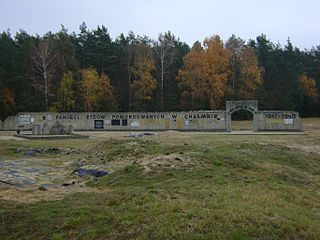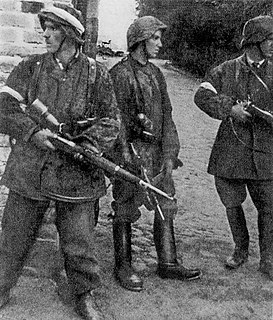 W
WChełmno or Kulmhof was the first of Nazi Germany's extermination camps and was situated 50 kilometres north of Łódź, near the village of Chełmno nad Nerem. Following the invasion of Poland in 1939, Germany annexed the area into the new territory of Reichsgau Wartheland. The camp, which was specifically intended for no other purpose than mass murder, operated from December 8, 1941 to April 11, 1943, parallel to Operation Reinhard during the deadliest phase of the Holocaust, and again from June 23, 1944 to January 18, 1945 during the Soviet counter-offensive. In 1943, modifications were made to the camp's killing methods as the reception building had already been dismantled.
 W
WFront for the Rebirth of Poland also translated as the Front for a Reborn Poland was a clandestine anti-Fascist organization formed in 1941 in occupied Poland during World War II, by a group of secular Catholics of Warsaw led by Zofia Kossak-Szczucka and Father Edmund Krauze. The Front upheld Christian ideals of the prewar Catholic Action movements existing in the Polish Second Republic as part of the cross national European groupings of lay Catholics.
 W
WThe Gauliga Generalgouvernement was the highest football league in Polish areas annexed by Nazi Germany after 1939, which were not incooperated into any of the Gaue, the so-called General Government. The name Gauliga is somewhat misleading in this case as the region was not part of the Gau system. The league existed from 1941 to 1945.
 W
WThousands of Jews lived in the towns of Dęblin and Irena in central Poland before World War II; Irena was the site of the Polish Air Force Academy from 1927. In September 1939, the town was captured during the German invasion of Poland and the persecution of Jews began with drafts into forced labor and the establishment of a Judenrat. A ghetto was established in Irena in November 1940. It initially consisted of six streets and was an open ghetto. Many ghetto inhabitants worked on labor projects for Dęblin Fortress, the railway, and the Luftwaffe. Beginning in May 1941, Jews were sent to labor camps around Dęblin from the Opole and Warsaw ghettos. Conditions in the ghetto worsened in late 1941 due to increased German restrictions on ghetto inhabitants and epidemics of typhus and dysentery.
 W
WMajdanek was a Nazi concentration and extermination camp built and operated by the SS on the outskirts of the city of Lublin during the German occupation of Poland in World War II. It had seven gas chambers, two wooden gallows, and some 227 structures in all, placing it among the largest of Nazi-run concentration camps. Although initially intended for forced labor rather than extermination, the camp was used to kill people on an industrial scale during Operation Reinhard, the German plan to murder all Jews within their own General Government territory of Poland. The camp, which operated from October 1, 1941, until July 22, 1944, was captured nearly intact, because the rapid advance of the Soviet Red Army during Operation Bagration prevented the SS from destroying most of its infrastructure, and the inept Deputy Camp Commandant Anton Thernes failed in his task of removing incriminating evidence of war crimes.
 W
WRzeczpospolita Polska was the official magazine of the Government Delegation for Poland. It was a source of instruction and information for other Polish underground organizations, including other underground publications, operating in occupied Poland.
 W
WPoniatowa concentration camp in the town of Poniatowa in occupied Poland, 36 kilometres (22 mi) west of Lublin, was established by the SS in the latter half of 1941 initially, to hold Soviet prisoners of war following Operation Barbarossa. By mid-1942, about 20,000 Soviet POWs had perished there from hunger, disease and executions. The camp was known at that time as the Stalag 359 Poniatowa. Afterwards, the Stammlager was redesigned an expanded as a concentration camp to provide slave labour supporting the German war effort, with workshops run by the SS Ostindustrie (Osti) on the grounds of the prewar Polish telecommunications equipment factory founded in the late 1930s. Poniatowa became part of the Majdanek concentration camp system of subcamps in the early autumn of 1943. The wholesale massacre of its mostly Jewish workforce took place during the Aktion Erntefest, thus concluding the Operation Reinhard in General Government.
 W
WThe Trawniki concentration camp was set up by Nazi Germany in the village of Trawniki about 40 kilometres (25 mi) southeast of Lublin during the occupation of Poland in World War II. Throughout its existence the camp served a dual function. It was organized on the grounds of the former Polish sugar refinery of the Central Industrial Region, and subdivided into at least three distinct zones.
 W
WTrawniki men were Central and Eastern European collaborators recruited from prisoner-of-war camps set up by Nazi Germany for Soviet Red Army soldiers captured in the border regions during Operation Barbarossa launched in June 1941. Thousands of these volunteers served in the General Government territory of German-occupied Poland until the end of World War II. Trawnikis belonged to a category of Hiwis, Nazi auxiliary forces recruited from native subjects.